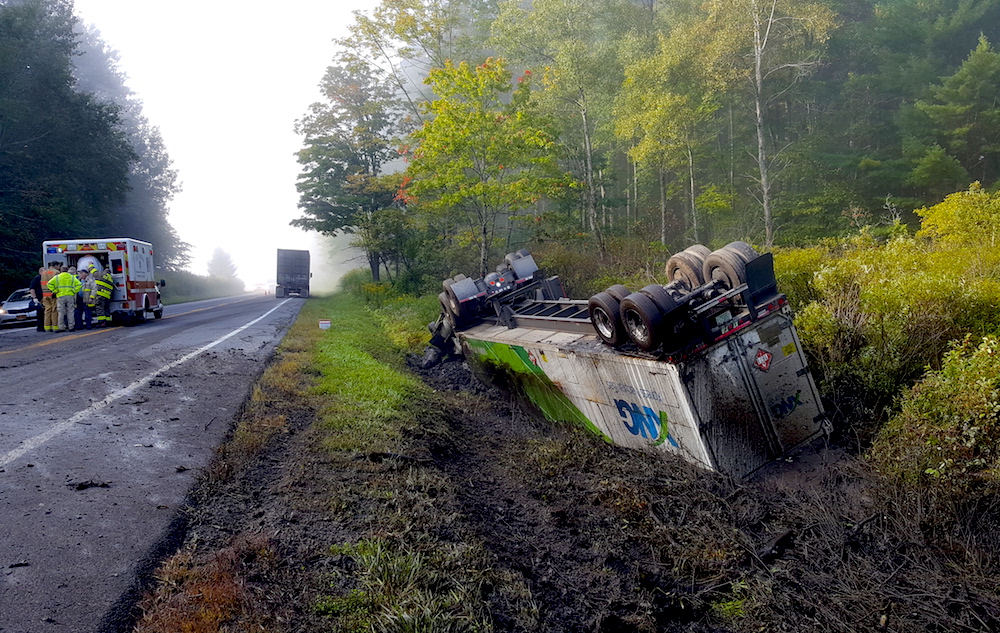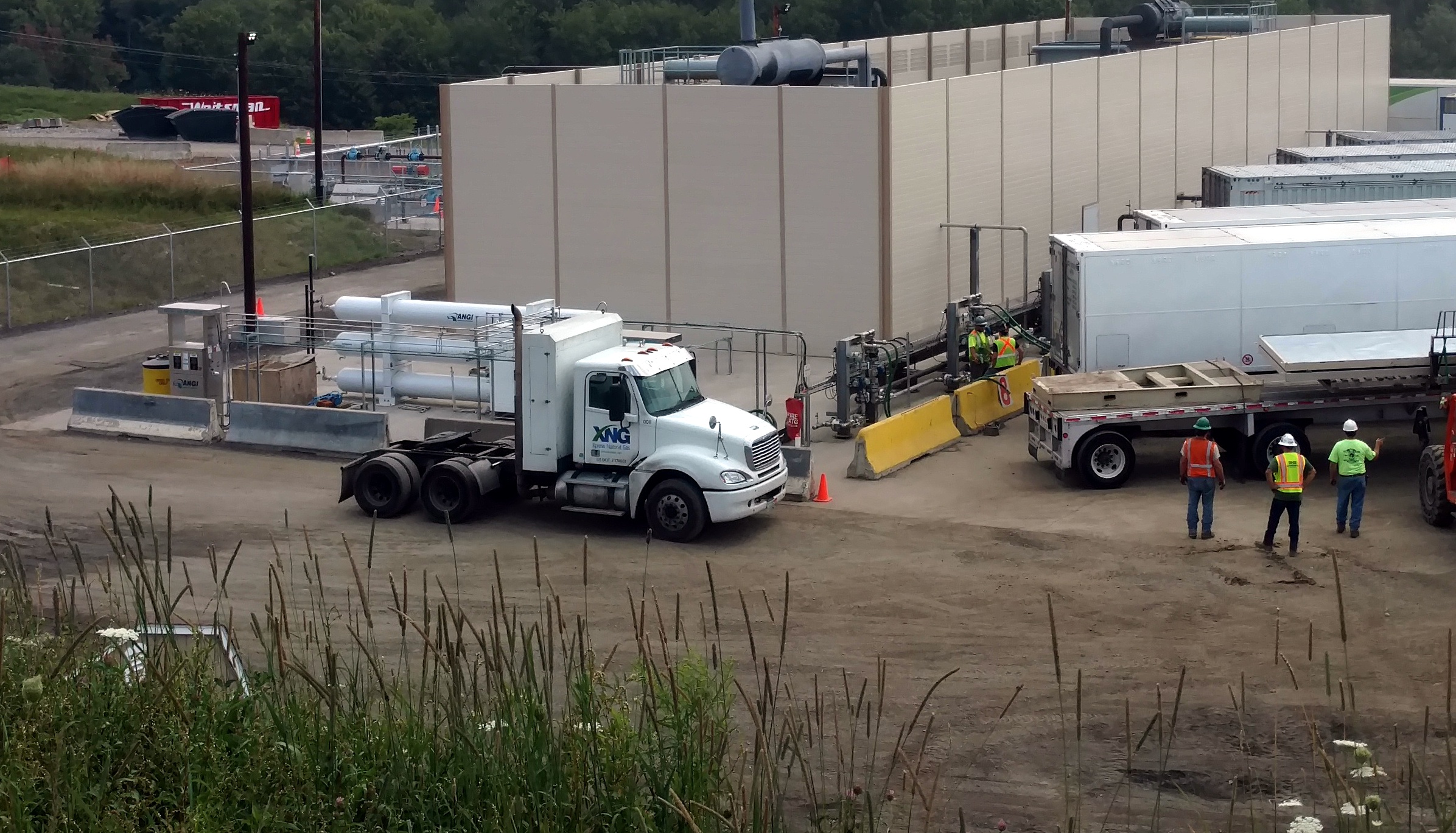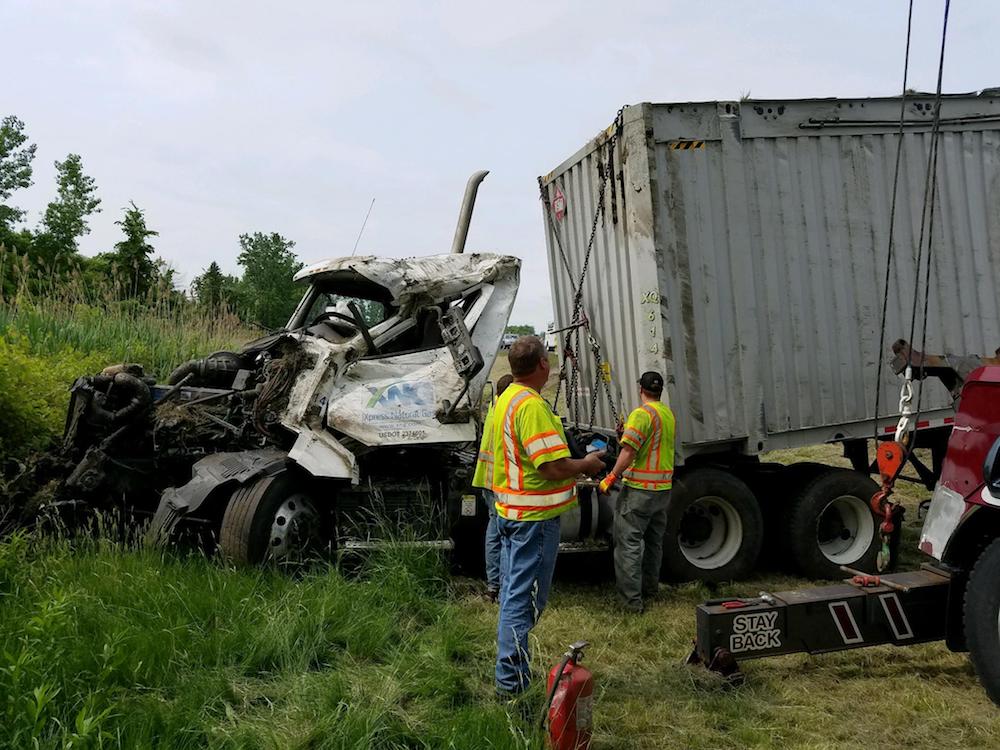For several years a mysterious fleet of tractor trailers loaded with natural gas cylinders has been crisscrossing U.S. roads, and in the dark early morning hours on Sunday, March 3, one drove off a highway near Cobleskill, New York, careened down an embankment, and flipped over. The driver had fallen asleep, according to a New York State police accident report, the truck was demolished, and “several tanks ruptured and were leaking” natural gas. Five nearby homes were evacuated.
For retired New York Department of Transportation commercial vehicle inspector Ron Barton, an alarm bell he had been ringing for months suddenly grew even more urgent. “This is a catastrophe waiting to happen,” says Barton.
The trucks are part of a little-known system of moving natural gas called “virtual pipelines.”
We’re 85% confident the CNG Tractor-Trailer that rolled over today on I-88 in Cobleskill, Schoharie Co. NY was owned by NG Advantage & departed from Springville, Susquehanna Co. PA, destined for International Paper in Ticonderoga, NY, fully loaded 11 tons methane. 1/2 pic.twitter.com/MXXDw71ADn
— Stop the Bomb Trucks (@StopBombTrucks) March 4, 2019
What Are Virtual Pipelines?
The practice involves loading cylinders filled with compressed natural gas (CNG) onto specially designed trucks and hauling the gas between existing pipelines or to areas not connected to a natural gas distribution system, such as rural towns, and remote factories, universities and hospitals.
Many environmental groups appear unaware of the topic, virtual pipelines have received virtually no national media attention, and some regulatory agencies seem unsure how to handle them.
“The concept,” wrote Pennsylvania energy expert John Siggins in a 2016 report, “was born out of the lack of pipeline infrastructure in the New England area,” and a natural gas boom in nearby Pennsylvania’s Marcellus shale play that lowered gas prices. “As the shale energy revolution took off,” wrote Siggins, “a system for off-pipeline natural gas deliveries became of interest.”
The 2016 report lists nine virtual pipeline companies, operating from Texas to Maine. Two of the most prominent companies are Xpress Natural Gas (XNG), based in Andover, Massachusetts, and Vermont-based NG Advantage.
Xpress Natural Gas trucks filling up with compressed natural gas at a facility in Forest Lake, Pennsylvania. Credit: © 2017 William Huston/Terra Vigilate
“I think it’s fair to say that it’s a very, very small part of the overall natural gas distribution system in the U.S. — much, much less than 1 percent of total natural gas used in the country,” said Kathryn Dyl, lead modeler on natural gas with the Energy Information Administration.
So small, her agency hasn’t tabbed up data on just how many companies are involved, where they are operating, or precisely what percentage of U.S. natural gas is being distributed in this manner. Virtual pipelines are “likely to increase,” said Dyl, “but certainly not to an appreciable level and will never be the preferred option.”
Where Are Virtual Pipelines Moving Gas?
Vermont’s Middlebury College as well as a nearby dairy and a hard cider company were served gas by an NG Advantage virtual pipeline from 2015 until 2018, when Vermont Gas completed a pipeline to the area. Presently XNG is supplying gas via virtual pipeline from the Maritimes & Northeast pipeline, in eastern Maine, to a pair of rural medical centers and a large potato farm.
“Rather than taking two or three years to develop a pipeline, we can be there in two or three months,” says CEO and co-founder John Nahill, in a promotional video on the company’s website.
But the route that has ignited Ron Barton and others to action is in central New York, where XNG has installed a virtual pipeline in the same region where the Constitution pipeline, which faced a surge of activism and was denied a key permit by the New York State Department of Environmental Conservation in 2016, would have run. The virtual pipeline goes from the gas-rich Marcellus shale fields of Susquehanna County, Pennsylvania, to an interstate pipeline in north-central New York called the Iroquois.
“Iroquois Gas Transmission is not waiting for the Constitution pipeline to get built — they’ve found a way around it,” stated a September 2017 article on the far-right industry news site Marcellus Drilling News. “That is … a virtual pipeline is now feeding an interstate pipeline in New York State with fracked gas from Pennsylvania.”
Time lapse video of Quantum Fuel Systems’ virtual pipeline trailers being produced in its Lake Forest, California, manufacturing facility.
To those in Otsego County, home to a series of picturesque lakes, Cooperstown — location of the well-visited Baseball Hall of Fame — and countless scenic farms, it appears as if the company has constructed an unregulated means of shipping gas born from fracking, a fuel whose extraction their own governor has banned.
“It’s slipping through the cracks and the risks are real,” said Keith Schue, an electrical engineer and member of Otsego 2000, a seasoned local environmental group that is protesting the trucks.
“They say it’s a virtual pipeline and it is,” said Schue. “There are so many of these trucks barreling down the road, literally a convoy of trucks going up from Pennsylvania to New York.”
XNG has not replied to questions.
Under Pressure
Virtual pipeline trucks, such as those operated by XNG and NG Advantage, pull gas out of pipelines at special compression facilities that compress the gas to 3600 pounds per square inch — more than two and half times the pressure of a typical interstate gas pipeline — and inject it into state-of-the-art cylinders that are then loaded onto the virtual pipeline trucks.
Two different companies have received special permits from the U.S. Pipeline and Hazardous Materials Safety Administration, or PHMSA, to employ these cylinders, California-based Quantum Fuel Systems LLC and Hexagon Lincoln LLC, out of Lincoln, Nebraska. The special permits state the cylinders must have “demonstrated the … ability to protect the tubes from damage due to front, rear, or side impact, and rollover.”
Ron Barton believes the repeated leaking of gas in recent rollover crashes involving virtual pipelines trucks means the trucks may currently be operating unlawfully, in violation of these special permits issued by PHMSA.
A police report for a July 2018 crash in Exeter, New York, involving an XNG virtual pipeline truck stated that natural gas leaked from the truck. Gas leaked again in the Cobleskill crash in March, which involved a truck operated by a North Canton, Ohio-based trucking company called KAG Leasing — KAG has not responded to questions on where they were hauling gas from or to.
“What is going to happen if there is a big roll-over in a populated area and there is a spark?” said Barton. “Now you’ve got a flame or fire.”
Cleaning up after an Xpress Natural Gas truck carrying compressed natural gas crashed in Albany County, New York, on June 2, 2018. Credit: Courtesy of William Huston/Terra Vigilate
The veteran inspector provides three possible pathways that would lead to a truck exploding. Some virtual pipeline trucks employ a special exhaust system, he says, and extreme heat from that could ignite leaking natural gas. The truck’s brakes can get so extraordinarily hot, reaching temperatures of 1,000 degrees Fahrenheit, that leaking gas would self-ignite. A severe crash could also generate a spark.
“The fact of the matter is,” Barton told DeSmog, “Pipeline and Hazardous Materials [PHMSA] should issue a cease and desist until the manufacturer can prove that they can meet those requirements of that special permit.” And, he added, “they should be doing an investigation.”
When asked for clarification on whether or not the virtual pipeline trucks were indeed violating the special permit, PHMSA spokesperson Darius Kirkwood said he could not answer the question.
“Generally speaking,” Kirkwood explained, “if someone violates provisions of a special permit, the special permit could very easily be rescinded. That can happen and does happen
Kirkwood later contacted me to say that the Federal Motor Carrier Safety Administration, a branch of the Department of Transportation that regulates trucking, “is indeed investigating the incidents.” When questioned on the status of the investigation, Duane DeBruyne, Deputy Director of Media Relations for that agency, said, “We are in receipt of your inquiry and are researching responses.” The agency has yet to follow up.
Mounting Risks for Kids and Climate
On an early spring afternoon with sweeping drifts of snow still covering the central New York landscape, Otsego 2000 president Nicole Dillingham drove along the route of XNG’s virtual pipeline. Earlier this year, the company moved the route away from a particularly narrow road that ran just beside a row of homes on the edge of a large lake.
But the destination of XNG’s virtual pipeline remains the Iroquois pipeline and the company’s trucks still ply her county’s rural roads. “There are no shoulders, there’s no room for error here,” she said. “We have 500,000 visitors every summer, so those trucks are sharing the road with our tourist visitors, and young children.” Near the base of a famously steep incline called Vickerman Hill, she spotted an XNG truck, coming down into the town of Mohawk on state route 28. At the same moment, waiting for the truck to pass so it could turn across 28, was a school bus. “The parents with children on that bus have no idea,” said Dillingham. “People don’t know how dangerous this is.”
Near the base of a famously steep incline called Vickerman Hill, an Xpress Natural Gas truck comes down into the town of Mohawk on state route 28, where a school bus waits for the truck to pass. Credit: Justin Nobel
Records with the Federal Motor Carrier Safety Administration indicate XNG has had nine crashes in New York since September 2017. The most frustrating part of the situation for residents like Dillingham is that her state officials have ducked the issue.
“PSC [Public Service Commission] does not have jurisdiction to investigate or impose requirements on CNG providers,” Kathleen Burgess, Secretary of the New York State Public Service Commission, wrote to Dillingham in July 2017. A letter that same month from William Leonard, Director of the Office of Modal Safety & Security with New York State Department of Transportation, indicated the situation was out of their hands and should be handled by the U.S. Department of Transportation.
A New York Department of Transportation official said as much in email replies to my questions. Repeated emails to Governor Cuomo’s office on virtual pipelines have gone unanswered.
Above it all looms the specter of climate change. Reports by the United Nations, the U.S. government, and numerous other institutions have painted a dire picture of what will happen to the planet and our civilization if a full kick away from fossil fuels isn’t swiftly implemented.
“We are absolutely condemning our children and grandchildren to a very unhappy future if we don’t stop burning fossil fuels,” said Schue, of Otsego 2000.
One of his biggest concerns with virtual pipelines is that their establishment helps prime a community or region for additional natural gas development. “In delivering gas to institutions you get communities hooked on gas, and that becomes the case to build the pipeline,” Schue explained. “It becomes a vicious cycle.”
Meanwhile, for retired New York Department of Transportation commercial vehicle inspector and whistle-blower Ron Barton, the calculus on virtual pipelines is much more simple. “These containers,” he said, “should not be on the road.”
Main image: First responders at the scene where an Xpress Natural Gas truck carrying compressed natural gas rolled over in Hartwick, New York, on September 12, 2017. Credit: Courtesy of William Huston/Terra Vigilate
Subscribe to our newsletter
Stay up to date with DeSmog news and alerts








